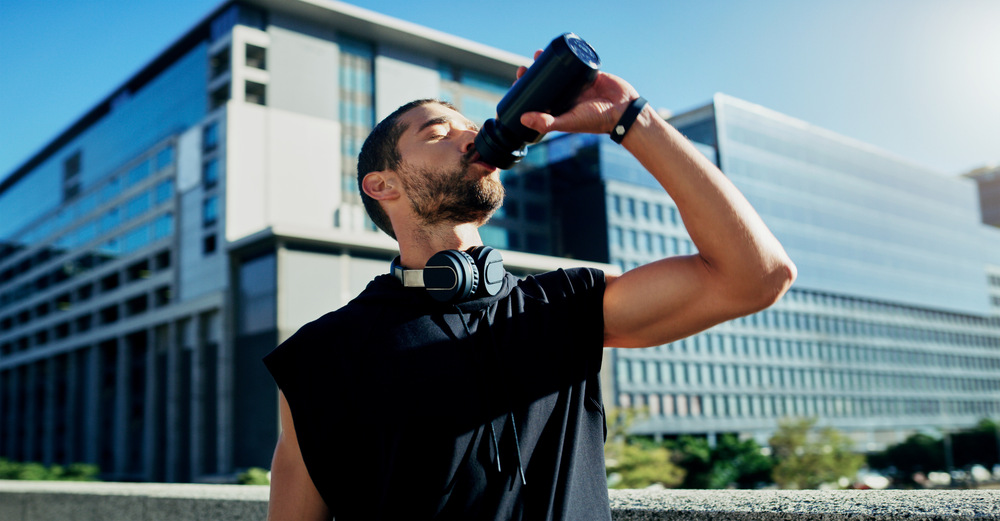Can you take creatine on an empty stomach? Benefits, dosage, side effects

Many physically active people looking to build muscle mass and improve their physique choose to use dietary supplements. One of the most popular options is creatine, whose effectiveness has been well-documented in scientific research.
When is the best time to take creatine to see results from supplementation? Can you take creatine on an empty stomach? We answer these and many other questions in the guide below. Find out when to take creatine to effectively boost your muscles’ energy stores without harming your health.
Table of Contents
What Is Creatine and How Does It Work?
Creatine is a well-known organic compound naturally present in human skeletal muscle. It is synthesized in the kidneys, liver, and pancreas from three amino acids—glycine, arginine, and methionine—and in small amounts in the brain. Once combined with a phosphate group to form phosphocreatine, it becomes an energy source for regenerating high-energy ATP.
Research shows creatine can help increase muscle strength and overall performance, especially during repeated bouts of intense physical activity. This makes it popular among both beginners and experienced strength, endurance, and physique athletes.
The most studied form is creatine monohydrate, a combination of creatine and water. It dissolves well in water, has a neutral taste, and is efficiently absorbed into muscle tissue. Creatine monohydrate supports lean muscle growth and enhances mitochondrial function, boosting energy levels during training.
Sports supplements also feature other forms of creatine, including creatine malate, creatine ethyl ester, creatine hydrochloride, and creatine citrate. Many creatine products are enriched with vitamins, minerals, and amino acids such as vitamin B6, beta-alanine, taurine, and citrulline malate.
Recommended creatine
Creatine on an Empty Stomach or After a Meal – Which Works Better?
People aiming to build muscle and improve performance often add creatine to their diet. But does timing matter? Is it better to take creatine on an empty stomach or with food?
Advanced formulas containing creatine monohydrate or creatine malate can be taken either before eating or after a meal.
If you choose to take creatine first thing in the morning, remember that after a night’s rest your body needs proper hydration. Creatine on an empty stomach is generally safe if used sensibly and in the correct dose. Excessive intake, however, can cause water retention, fatigue, muscle cramps, and rapid weight gain.
Benefits of Taking Creatine on an Empty Stomach
Many athletes take creatine before breakfast. When taken right after waking, creatine may be absorbed more quickly into the bloodstream, helping muscles saturate faster. However, this approach doesn’t suit everyone. Those with sensitive digestion may experience stomach discomfort or mild nausea when taking creatine without food.
Is Taking Creatine on an Empty Stomach Harmful?
Athletes often ask, “Can creatine on an empty stomach be harmful?” Taking creatine without food may cause side effects such as stomach pain, nausea, or dehydration—especially if consumed in large amounts or by people with digestive issues. In these cases, it may be better to take creatine with a light first meal or mix it in a larger volume of water.
How to Take Creatine for Best Results
Creatine supplementation works best when combined with a balanced diet and a proper strength training plan. But does timing affect muscle gain and recovery? Morning or evening?
Some wonder whether creatine should be taken before or after workouts. In practice, timing is less important. Depending on training goals and personal preference, creatine can be taken either pre- or post-workout. The key is consistency—maintaining stable creatine levels yields the best results. You can take creatine before or after exercise and on rest days as well.
To maximize benefits, creatine can be taken alone or with other valuable nutrients.
If you’re unsure, start by combining creatine with a carbohydrate or carb-protein supplement. Another good option is to pair creatine monohydrate or malate with BCAA amino acids. Always follow the manufacturer’s dosage recommendations to avoid side effects.
Creatine Loading and Maintenance Phases
There are several supplementation strategies. A once-popular approach was the “loading phase,” where higher doses are taken for 5–7 days—about 20 g per day divided into smaller servings. This rapidly saturates muscles with creatine in preparation for intense training.
An alternative is the maintenance method—taking a steady daily dose of 3–5 g to keep creatine levels optimal. This lower-dose approach is easier on the body and preferred by many athletes. If starting creatine on an empty stomach, it’s best to begin with about 3 g daily.
Best Creatine Forms to Take on an Empty Stomach
Creatine is a versatile and well-regarded supplement for supporting anabolic processes. If you’re considering taking creatine without food, choosing the right form is crucial. Many athletes opt for micronized creatine monohydrate, valued for its excellent solubility and easy absorption.
Those with digestive issues should note that some forms—like creatine hydrochloride or creatine malate—are acidic, which may cause stomach discomfort or nausea when taken on an empty stomach. For sensitive individuals, creatine monohydrate is usually the preferred option.
Summary: Is It Worth Taking Creatine on an Empty Stomach?
Creatine is one of the most researched sports supplements. Regular use alongside strength training can enhance performance and muscle strength. It remains a favorite among strength and endurance athletes, including weightlifters, martial artists, bodybuilders, and sprinters.
Hopefully this guide has clarified creatine timing and whether it can be taken without food. If you have a sensitive stomach and often deal with bloating, constipation, or abdominal pain, it’s best to take creatine with a meal.
Well-planned creatine supplementation can boost performance, increase strength, and improve training outcomes. Before starting, learn about the available creatine types and choose one that fits your needs. The Polish brand OstroVit offers a wide selection of thoroughly tested products that meet high quality and safety standards.

